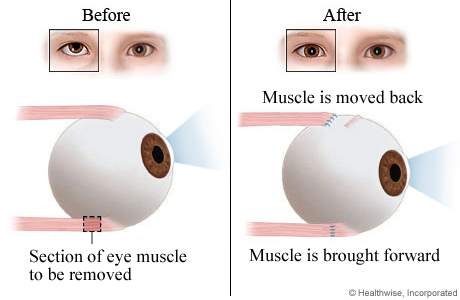Strabismus in children: Overview
Strabismus means that both eyes do not look at the same thing at the same time. One eye may look straight ahead while the other eye looks in another direction. It is sometimes called "cross-eye" or "walleye." Surgery can fix this problem.
Your child will be asleep during the surgery. The doctor makes a cut over the white part of the eye to find the muscles that need to be fixed. The cut is called an incision. Then the doctor loosens or tightens the eye muscles and uses small stitches to hold the muscles in their new position. These small stitches are called sutures.
Most children go home after they wake up. The sutures in the eye don't need to be removed. They will dissolve in a few weeks.
Strabismus Surgery

Surgery to treat strabismus changes the position of the eye muscles to adjust the position of the eye. After surgery, both eyes will be able to focus on the same point at the same time.
After your child's strabismus surgery: When to call
Call your doctor now or seek immediate medical care if:
- Your child has signs of an eye infection, such as:
- Pus or thick discharge coming from the eye.
- Redness or swelling around the eye.
- A fever.
- Your child has new or worse eye pain.
- Your child has vision changes.
- It seems like there is something in your child's eye.
- Light hurts your child's eye.
- Your child's eye bleeds. A small amount of pink-colored tears is normal for a day or two after surgery.
- Your child has pain that does not get better after they take pain medicine.
Watch closely for any changes in your child's health, and be sure to contact your doctor if:
- Your child does not get better as expected.
How do you prepare for your child's strabismus surgery?
Surgery can be stressful for both your child and you. This information will help you understand what you can expect. And it will help you safely prepare for your child's surgery.
Preparing for surgery
- Talk to your child about the surgery. Tell your child that this surgery will make your child's eyes healthier. Hospitals know how to take care of children. The staff will do all they can to make it easier for your child.
- Ask if a special tour of the surgery area and hospital is available. This may make your child feel less nervous about what happens.
- Plan for your child's recovery time. Your child may need more of your time right after the surgery, both for care and for comfort.
- Understand exactly what surgery is planned, along with the risks, benefits, and other options.
- Tell the doctor ALL the medicines, vitamins, supplements, and herbal remedies your child takes. Some may increase the risk of problems during the surgery. Your doctor will tell you if your child should stop taking any of them before the surgery and how soon to do it.
The day before surgery
- A nurse may call you (or you may need to call the hospital). This is to confirm the time and date of your child's surgery and answer any questions.
- Remember to follow your doctor's instructions about your child taking or stopping medicines before surgery. This includes over-the-counter medicines.
How can you care for your child after strabismus surgery?
Medicines
- Your doctor will tell you if and when your child can restart their medicines. The doctor will also give you instructions about your child taking any new medicines.
- Give pain medicines exactly as directed.
- If the doctor gave you a prescription medicine for your child's pain, give it as prescribed.
- If your child is not taking a prescription pain medicine, ask your doctor if you can give an over-the-counter medicine.
- If the doctor prescribed eyedrops, use the drops exactly as directed. To put in eyedrops or ointment:
- Tilt your child's head back, and pull the lower eyelid down with one finger. Drop or squirt the medicine inside the lower lid. Ask your child to close the eye for 30 to 60 seconds to let the drops or ointment move around. Do not touch the ointment or dropper tip to your child's eyelashes or any other surface.
Exercise
- Your child can go back to their usual activities in a day or two.
- For 1 week, do not let your child play sports with a ball or do any activity where their eye could get hit.
- For 2 weeks, your child should not swim.
Other instructions
- If your child's eye is sore and swollen the day after surgery, you can put ice or a cold pack on the eye for 10 to 20 minutes at a time. Put a thin cloth between the ice and your child's skin. A bag of frozen peas wrapped in a towel also works well.
©2011-2025 Healthwise, Incorporated
